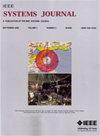主动可重构智能表面辅助物联网系统中用户对安全性能分析
IF 4.4
3区 计算机科学
Q1 COMPUTER SCIENCE, INFORMATION SYSTEMS
引用次数: 0
摘要
我们研究了主动可重构智能表面(ARIS)与非正交多址(NOMA)的集成,以提高物联网(IoT)系统的保密性能和安全能力。该系统模型结合了ARIS和NOMA,允许改进的功率分配和更高的安全性。特别研究了ARIS-NOMA系统在被用户对组中的恶意用户窃听时的物理层安全性。为了提供真实的影响,我们检查了主要的系统性能指标,包括连接中断概率、保密中断概率(SOP)和严格正保密能力,它们是评估系统可靠性、安全性和可实现保密率的重要指导方针。我们评估了ARIS、窃听者和基站之间的距离对SOP的影响。我们推导了NOMA方案的最佳功率分配因子,为系统设计和参数调整提供了见解,以实现稳健和安全的运行。与使用正交多址的基准模型相比,我们表明ARIS-NOMA是一种有前途的解决方案,可以进一步增强物联网网络的安全性和保密性。本文章由计算机程序翻译,如有差异,请以英文原文为准。
Secure Performance Analysis of User Pairs in Active Reconfigurable Intelligent Surface-Aided IoT Systems
We investigate the integration of an active reconfigurable intelligent surface (ARIS) with nonorthogonal multiple access (NOMA) to enhance the secrecy performance and the security capabilities in Internet of Things (IoT) systems. The system model incorporates ARIS and NOMA, allowing for improved power allocation and higher security. In particular, the physical-layer security of an ARIS-NOMA system is investigated when the system is subject to eavesdropping by a malicious user in a user pair group. To provide real-world impact, we examine the main system performance metrics, including the connection outage probability, the secrecy outage probability (SOP), and the strictly positive secrecy capacity, which are important guidelines in evaluating the system's reliability, security, and achievable secrecy rates. We evaluate the impact of distances between the ARIS, the eavesdropper, and the base station on the SOP. We derive the optimal power allocation factors in the NOMA scheme, which provides insights into the system design and parameter adjustment to achieve robust and secure operation. In comparison to a benchmark model using the orthogonal multiple access, we show ARIS-NOMA is a promising solution to further enhance security and secrecy in IoT networks.
求助全文
通过发布文献求助,成功后即可免费获取论文全文。
去求助
来源期刊

IEEE Systems Journal
工程技术-电信学
CiteScore
9.80
自引率
6.80%
发文量
572
审稿时长
4.9 months
期刊介绍:
This publication provides a systems-level, focused forum for application-oriented manuscripts that address complex systems and system-of-systems of national and global significance. It intends to encourage and facilitate cooperation and interaction among IEEE Societies with systems-level and systems engineering interest, and to attract non-IEEE contributors and readers from around the globe. Our IEEE Systems Council job is to address issues in new ways that are not solvable in the domains of the existing IEEE or other societies or global organizations. These problems do not fit within traditional hierarchical boundaries. For example, disaster response such as that triggered by Hurricane Katrina, tsunamis, or current volcanic eruptions is not solvable by pure engineering solutions. We need to think about changing and enlarging the paradigm to include systems issues.
 求助内容:
求助内容: 应助结果提醒方式:
应助结果提醒方式:


